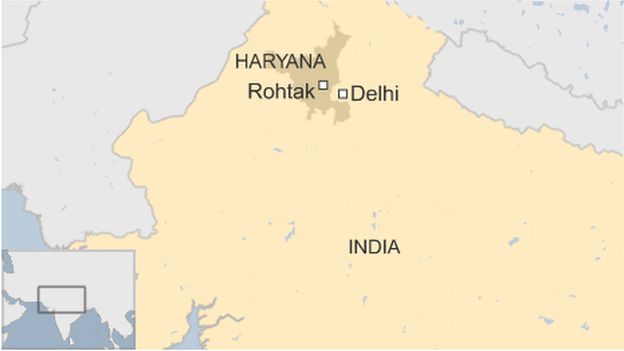More than 10 million people in India's capital, Delhi, are without water after protesters sabotaged a key canal which supplies much of the city.
The army took control of the Munak canal after Jat community protesters, angry at caste job quotas, seized it.
Keshav Chandra, head of Delhi's water board, told the BBC it would take "three to four days" before normal supplies resumed to affected areas.
All Delhi's schools have been closed because of the water crisis.
Sixteen people have been killed and hundreds hurt in three days of riots.
Sixteen million people live in Delhi, and around three-fifths of the city's water is supplied by the canal, which runs through the neighbouring state of Haryana.
Mr Chandra said that prior warnings meant that people had managed to save water, and tankers had been despatched to affected areas of the city, but that this would not be enough to make up for the shortfall.
The army took control of parts of the canal on Monday morning, but repairs are expected to take time.
The BBC's Sanjoy Majumder, who is near Delhi's border with neighbouring Haryana state, said protesters who have set up road blocks are refusing to budge.
"We don't trust them. Let's get something in writing. Let them spell it out," one demonstrator who refused to be named told the BBC.
 Delhi Jal Board
Delhi Jal Board EPA
EPA EPA
EPA
Delhi Chief Minister Arvind Kejriwal tweeted that the army was "trying to assess in how much time water would reach Delhi and whether any damage had been done to the canal".
Protesters went on the rampage despite a curfew and the deployment of the army, which is reported to have opened fire on them in the districts of Rohtak and Jhajjar.
Why are the Jats angry?
- The land-owning Jat community is relatively affluent and has traditionally been seen as upper caste.
- They are mainly based in Haryana and seven other states in northern India.
- Comprising 27% of the voters in Haryana and dominating a third of the 90 state assembly seats, they are a politically influential community. Seven of the 10 chief ministers in Haryana have been Jats.
- The Jats are currently listed as upper caste but the demonstrators have been demanding inclusion in caste quotas for jobs and education opportunities that have been available to lower castes since 1991.
- In March 2014 the Congress-led national government said it would re-categorise Jats as Other Backward Castes (OBC), opening the way to government job quotas.
- But India's Supreme Court ruled in 2015 that the Jats were not a backward community.
- As jobs have dried up in the private sector and farming incomes have declined, the community has demanded the reinstatement of their backward caste status to enable them to secure government jobs.
Haryana state minister Ram Bilas Sharma said the situation was returning to normal, traffic had resumed on national highways and that railway lines between Delhi and the cities of Jaipur and Chandigarh had reopened.
Mr Sharma also confirmed that the government would introduce a bill on reservations and quotas for the Jat community in the next assembly session, although he did not say when that would be.

Meanwhile, India's federal government has said it will set up a top-level committee to look into the grievances of Jats.
The violence had earlier forced the closure of several key roads and national highways, and paralysed the railway system in northern India.
No comments:
Post a Comment